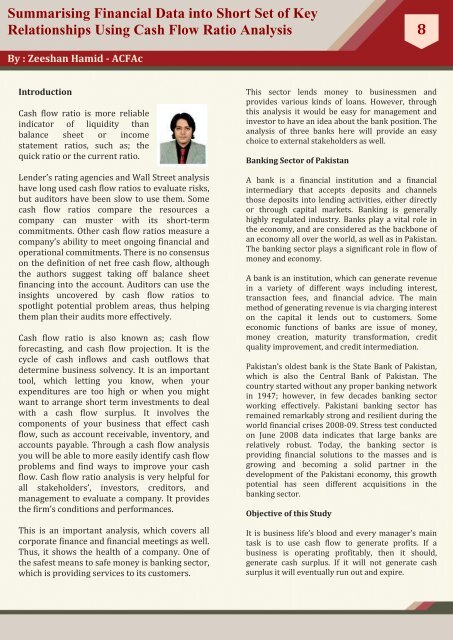Financial Accountant Journal-March-2014
Financial Accountant Journal-March-2014
Financial Accountant Journal-March-2014
Create successful ePaper yourself
Turn your PDF publications into a flip-book with our unique Google optimized e-Paper software.
Summarising <strong>Financial</strong> Data into Short Set of Key<br />
Relationships Using Cash Flow Ratio Analysis<br />
8<br />
By : Zeeshan Hamid - ACFAc<br />
Introduction<br />
Cash flow ratio is more reliable<br />
indicator of liquidity than<br />
balance sheet or income<br />
statement ratios, such as; the<br />
quick ratio or the current ratio.<br />
Lender’s rating agencies and Wall Street analysis<br />
have long used cash flow ratios to evaluate risks,<br />
but auditors have been slow to use them. Some<br />
cash flow ratios compare the resources a<br />
company can muster with its short-term<br />
commitments. Other cash flow ratios measure a<br />
company’s ability to meet ongoing financial and<br />
operational commitments. There is no consensus<br />
on the definition of net free cash flow, although<br />
the authors suggest taking off balance sheet<br />
financing into the account. Auditors can use the<br />
insights uncovered by cash flow ratios to<br />
spotlight potential problem areas, thus helping<br />
them plan their audits more effectively.<br />
Cash flow ratio is also known as; cash flow<br />
forecasting, and cash flow projection. It is the<br />
cycle of cash inflows and cash outflows that<br />
determine business solvency. It is an important<br />
tool, which letting you know, when your<br />
expenditures are too high or when you might<br />
want to arrange short term investments to deal<br />
with a cash flow surplus. It involves the<br />
components of your business that effect cash<br />
flow, such as account receivable, inventory, and<br />
accounts payable. Through a cash flow analysis<br />
you will be able to more easily identify cash flow<br />
problems and find ways to improve your cash<br />
flow. Cash flow ratio analysis is very helpful for<br />
all stakeholders’, investors, creditors, and<br />
management to evaluate a company. It provides<br />
the firm’s conditions and performances.<br />
This is an important analysis, which covers all<br />
corporate finance and financial meetings as well.<br />
Thus, it shows the health of a company. One of<br />
the safest means to safe money is banking sector,<br />
which is providing services to its customers.<br />
This sector lends money to businessmen and<br />
provides various kinds of loans. However, through<br />
this analysis it would be easy for management and<br />
investor to have an idea about the bank position. The<br />
analysis of three banks here will provide an easy<br />
choice to external stakeholders as well.<br />
Banking Sector of Pakistan<br />
A bank is a financial institution and a financial<br />
intermediary that accepts deposits and channels<br />
those deposits into lending activities, either directly<br />
or through capital markets. Banking is generally<br />
highly regulated industry. Banks play a vital role in<br />
the economy, and are considered as the backbone of<br />
an economy all over the world, as well as in Pakistan.<br />
The banking sector plays a significant role in flow of<br />
money and economy.<br />
A bank is an institution, which can generate revenue<br />
in a variety of different ways including interest,<br />
transaction fees, and financial advice. The main<br />
method of generating revenue is via charging interest<br />
on the capital it lends out to customers. Some<br />
economic functions of banks are issue of money,<br />
money creation, maturity transformation, credit<br />
quality improvement, and credit intermediation.<br />
Pakistan’s oldest bank is the State Bank of Pakistan,<br />
which is also the Central Bank of Pakistan. The<br />
country started without any proper banking network<br />
in 1947; however, in few decades banking sector<br />
working effectively. Pakistani banking sector has<br />
remained remarkably strong and resilient during the<br />
world financial crises 2008-09. Stress test conducted<br />
on June 2008 data indicates that large banks are<br />
relatively robust. Today, the banking sector is<br />
providing financial solutions to the masses and is<br />
growing and becoming a solid partner in the<br />
development of the Pakistani economy, this growth<br />
potential has seen different acquisitions in the<br />
banking sector.<br />
Objective of this Study<br />
It is business life’s blood and every manager’s main<br />
task is to use cash flow to generate profits. If a<br />
business is operating profitably, then it should,<br />
generate cash surplus. If it will not generate cash<br />
surplus it will eventually run out and expire.


